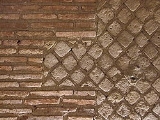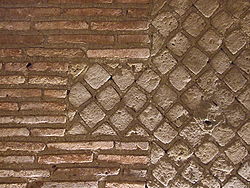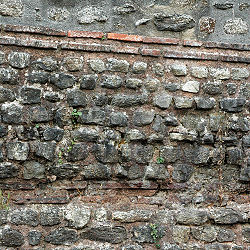
Opus mixtum
Encyclopedia


Roman architecture
Ancient Roman architecture adopted certain aspects of Ancient Greek architecture, creating a new architectural style. The Romans were indebted to their Etruscan neighbors and forefathers who supplied them with a wealth of knowledge essential for future architectural solutions, such as hydraulics...
construction technique. It can consist in a mix of opus reticulatum
Opus reticulatum
Opus reticulatum is a form of brickwork used in ancient Roman architecture. It consists of diamond-shaped bricks of tuff placed around a core of opus caementicium...
and at the angles and the sides of opus latericium
Opus latericium
thumb|250px|Example of opus latericium on a tomb of the ancient [[Appian Way]] in [[Rome]].Opus latericium is an ancient Roman form of construction in which coarse-laid brickwork is used to face a core of opus caementicium....
.
It can also consist of opus vittatum
Opus vittatum
250px|thumb|Theatre of [[Augustus]] in [[Augusta Raurica]]. The steps are in opus vittatum.Opus vittatum was an ancient Roman construction technique, sometimes square with tuff blocks intersected by one or more brick-bands at regular or irregular distances, and Opus caementicium.This technique was...
and opus testaceum.
Opus mixtum was used in particular during the age of Emperor Hadrian
Hadrian
Hadrian , was Roman Emperor from 117 to 138. He is best known for building Hadrian's Wall, which marked the northern limit of Roman Britain. In Rome, he re-built the Pantheon and constructed the Temple of Venus and Roma. In addition to being emperor, Hadrian was a humanist and was philhellene in...
(2nd century AD).

